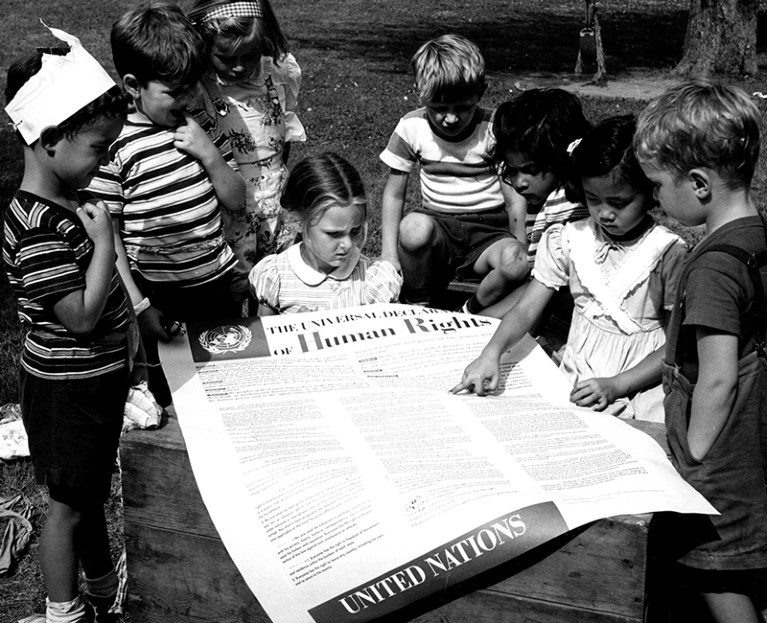
The new guidance is founded on the first article of the 1948 Universal Declaration of Human Rights — all humans are “equal in dignity and rights”.Credit: Universal History Archive/Universal Images Group/Getty
In 1971, psychologist Philip Zimbardo set out to examine how the situations we find ourselves in affect our behaviour. He put human volunteers in a mock prison on the Stanford University campus in California. Participants were assigned the roles of ‘prisoner’ or ‘guard’ and asked to behave in ways befitting their roles. The experiment was extraordinary in its realism — ‘prisoners’ were even ‘arrested’ by local police. Although intended to run for two weeks, it ended on the sixth day. ‘Guards’ had subjected ‘prisoners’ to increasingly abusive, dehumanizing and brutal behaviours, causing extraordinary distress (P. G. Zimbardo Cognition 2, 243–256; 1973).
The Stanford prison experiment prompted much discussion about the ethics of psychological research, and rules were tightened. It could not be reproduced today — ethics committees and institutional review boards would not approve research posing such a high risk of psychological harm to participants, no matter the potential benefit to knowledge.
There are now several well-established ethics frameworks that govern studies involving human participants, including the 1964 Declaration of Helsinki (amended most recently in 2013; see World Medical Association JAMA 310, 2191–2194; 2013) and the 1979 Belmont Report (see go.nature.com/3mj33xy). But these are generally silent about the benefits and harms of academic research whose conclusions could affect groups of people that haven’t directly participated. Examples include research that could lead to people being stigmatized, discriminated against or subjected to racism, sexism or homophobia, among other things. Such work might be used to justify undermining the rights of specific groups, simply because of their social characteristics.
Science must overcome its racist legacy: Nature’s guest editors speak
Guidance developed by Springer Nature editors aims to fill this gap in the frameworks (see go.nature.com/3mcuozj). In essence, it encourages authors, reviewers and editors to respect the dignity and rights of groups of people. Specifically, it means at least three things: first, that the research community should consider potentially harmful implications of research as applied to groups; second, that the community should strive to minimize the potential for misuse and the risks of harm to these groups; and third, that authors should use respectful, non-stigmatizing language in their manuscripts.
The guidance applies principles that are already cornerstones of research ethics (see go.nature.com/3anccnr): beneficence (a moral obligation to act for the benefit of others) and non-maleficence (a duty to avoid harm). It takes as a foundation the first article of the Universal Declaration of Human Rights — all humans are “equal in dignity and rights”. The declaration was adopted by the United Nations in 1948, following the atrocities of the Second World War, which the international community pledged would never happen again.
Editors, authors and reviewers should together consider and discuss benefits and harms that might emerge from manuscripts dealing with human population groups, and discuss when potential harms warrant revisions. Ethical concerns need to be flagged about research that could fuel hate speech; about potentially denigrating images; about content that could be used to undermine the dignity or rights of a human group; and about content that could cause harm in other ways. Although cases are not always clear cut, if publication risks people being harmed, authors and editors need to consider those risks against any benefits that could arise from publication.
The past few years have seen several examples of not just correction or retraction, but also removal of the kind of content that this guidance seeks to discourage. The removal of retracted content distorts the historical record, impedes accountability and prevents current and future generations from critically examining both the work and our actions. Unless there is a legal or public-health imperative, content published by Nature Portfolio journals that is retracted because it was deemed harmful to human population groups will be labelled with a retraction notice but will not be removed from the record (see go.nature.com/3qihqbd).
This guidance is ultimately about protecting people from harm. It is not about stifling ethically conducted research on differences between individuals or human groups, or discouraging work that is socially or academically controversial. Science has for too long been used to prop up structural inequalities and discrimination in society, perpetuating injustice. Our guidance takes a step towards countering this. Academic freedom is a fundamental and non-negotiable premise of scholarship. However, it is not without limits. All academic research requires ethical consideration to maximize benefits and reduce or eliminate harms.

 Science must overcome its racist legacy: Nature’s guest editors speak
Science must overcome its racist legacy: Nature’s guest editors speak
 Nature addresses helicopter research and ethics dumping
Nature addresses helicopter research and ethics dumping
 Nature journals raise the bar on sex and gender reporting in research
Nature journals raise the bar on sex and gender reporting in research






